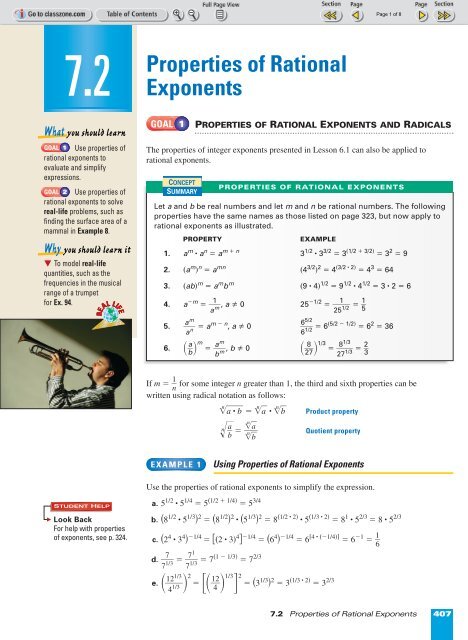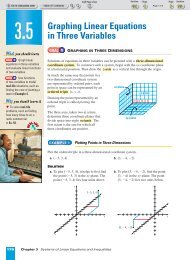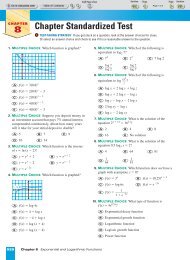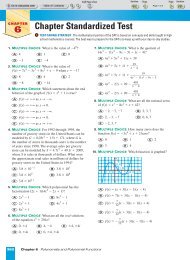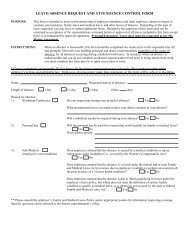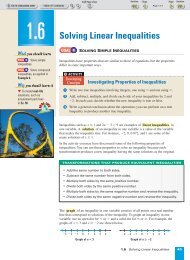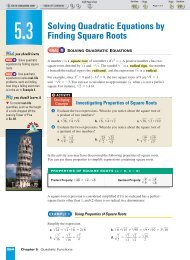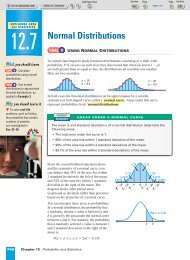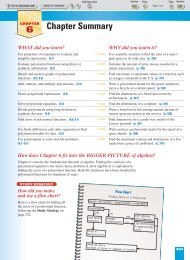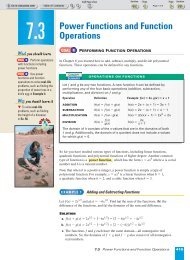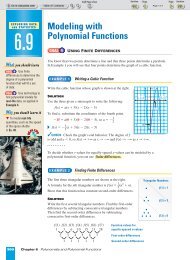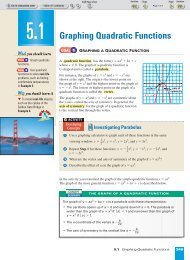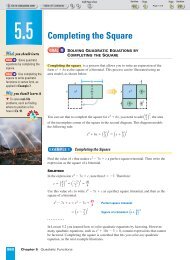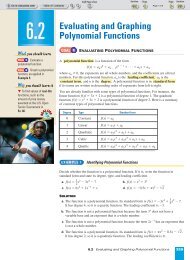Alg. 2 Chapter 7.2 - Beau Chene High School Home Page
Alg. 2 Chapter 7.2 - Beau Chene High School Home Page
Alg. 2 Chapter 7.2 - Beau Chene High School Home Page
You also want an ePaper? Increase the reach of your titles
YUMPU automatically turns print PDFs into web optimized ePapers that Google loves.
<strong>7.2</strong><br />
Properties of Rational<br />
Exponents<br />
What you should learn<br />
GOAL 1 Use properties of<br />
rational exponents to<br />
evaluate and simplify<br />
expressions.<br />
GOAL 2 Use properties of<br />
rational exponents to solve<br />
real-life problems, such as<br />
finding the surface area of a<br />
mammal in Example 8.<br />
Why you should learn it<br />
To model real-life<br />
quantities, such as the<br />
frequencies in the musical<br />
range of a trumpet<br />
for Ex. 94.<br />
REAL<br />
LIFE<br />
GOAL 1<br />
PROPERTIES OF RATIONAL EXPONENTS AND RADICALS<br />
The properties of integer exponents presented in Lesson 6.1 can also be applied to<br />
rational exponents.<br />
CONCEPT<br />
SUMMARY<br />
Let a and b be real numbers and let m and n be rational numbers. The following<br />
properties have the same names as those listed on page 323, but now apply to<br />
rational exponents as illustrated.<br />
PROPERTY<br />
PROPERTIES OF RATIONAL EXPONENTS<br />
EXAMPLE<br />
1. a m • a n = a m + n 3 1/2 • 3 3/2 = 3 (1/2 + 3/2) = 3 2 = 9<br />
2. (a m ) n = a mn (4 3/2 ) 2 = 4 (3/2 • 2) = 4 3 = 64<br />
3. (ab) m = a m b m (9 • 4) 1/2 = 9 1/2 • 4 1/2 = 3 • 2 = 6<br />
4. a ºm 1<br />
= , a ≠ 0 25 º1/2 1 1<br />
= = <br />
a<br />
m<br />
25<br />
1/2 5<br />
a<br />
5. m = a m º n , a ≠ 0 6 = 6 (5/2 º 1/2) = 6 2 = 36<br />
a<br />
n<br />
1/<br />
2<br />
6<br />
5/<br />
2<br />
a<br />
6. b<br />
m a 8<br />
= , b ≠ 0 2 7 1/3 2<br />
<br />
m = = <br />
2<br />
1/3<br />
<br />
87 3<br />
b m<br />
1/3<br />
If m = 1 n for some integer n greater than 1, the third and sixth properties can be<br />
written using radical notation as follows:<br />
n a • b = n a • n b<br />
n a<br />
=<br />
b<br />
n a<br />
<br />
<br />
n<br />
b<br />
Product property<br />
Quotient property<br />
EXAMPLE 1<br />
Using Properties of Rational Exponents<br />
STUDENT HELP<br />
Look Back<br />
For help with properties<br />
of exponents, see p. 324.<br />
Use the properties of rational exponents to simplify the expression.<br />
a. 5 1/2 • 5 1/4 = 5 (1/2 + 1/4) = 5 3/4<br />
b. (8 1/2 • 5 1/3 ) 2 = (8 1/2 ) 2 • (5 1/3 ) 2 = 8 (1/2 • 2) • 5 (1/3 • 2) = 8 1 • 5 2/3 = 8 • 5 2/3<br />
c. (2 4 • 3 4 ) º1/4 = (2 • 3) 4 º1/4 = (6 4 ) º1/4 = 6 [4 • (º1/4)] = 6 º1 1<br />
= 6<br />
1<br />
7<br />
d. <br />
7<br />
1/3 = 7<br />
= 7 (1 º 1/3) = 7 2/3<br />
1/3<br />
7<br />
12<br />
e. 2 = 1 2<br />
<br />
4<br />
1/3<br />
1/3 2 = (3 1/3 ) 2 = 3 (1/3 • 2) = 3 2/3<br />
4<br />
1/3<br />
<strong>7.2</strong> Properties of Rational Exponents 407
EXAMPLE 2<br />
Using Properties of Radicals<br />
Use the properties of radicals to simplify the expression.<br />
a. 3 4 • 3 16 = 3 4 • 16 = 3 64 = 4 Use the product property.<br />
4 162<br />
<br />
4 2<br />
b. = 4 = 4 81 = 3 Use the quotient property.<br />
. . . . . . . . . .<br />
162<br />
2<br />
For a radical to be in simplest form, you must not only apply the properties of<br />
radicals, but also remove any perfect nth powers (other than 1) and rationalize any<br />
denominators.<br />
EXAMPLE 3<br />
Writing Radicals in Simplest Form<br />
STUDENT HELP<br />
HOMEWORK HELP<br />
Visit our Web site<br />
www.mcdougallittell.com<br />
for extra examples.<br />
INTERNET<br />
Write the expression in simplest form.<br />
a. 3 54 = 3 27 • 2 Factor out perfect cube.<br />
= 3 27 • 3 2 Product property<br />
= 3 3 2 Simplify.<br />
b. <br />
5 3<br />
= 5 3 • 8<br />
<br />
4<br />
4 • 8<br />
Make the denominator a perfect fifth power.<br />
. . . . . . . . . .<br />
24<br />
32<br />
= 5 Simplify.<br />
5 24<br />
= Quotient property<br />
5 32<br />
5 24<br />
= Simplify.<br />
2<br />
Two radical expressions are like radicals if they have the same index and the same<br />
radicand. For instance, 3 2 and 4 3 2 are like radicals. To add or subtract like<br />
radicals, use the distributive property.<br />
EXAMPLE 4<br />
Adding and Subtracting Roots and Radicals<br />
Perform the indicated operation.<br />
a. 7(6 1/5 ) + 2(6 1/5 ) = (7 + 2)(6 1/5 ) = 9(6 1/5 )<br />
b. 3 16 º 3 2 = 3 8 • 2 º 3 2<br />
= 3 8 • 3 2 º 3 2<br />
= 2 3 2 º 3 2<br />
= (2 º 1) 3 2<br />
= 3 2<br />
408 <strong>Chapter</strong> 7 Powers, Roots, and Radicals
The properties of rational exponents and radicals can also be applied to expressions<br />
involving variables. Because a variable can be positive, negative or zero, sometimes<br />
absolute value is needed when simplifying a variable expression.<br />
n x n = x when n is odd 7 2 7 = 2 and 7 (º2) 7 = º2<br />
n x n = |x| when n is even 4 5 4 = 5 and 4 (º5) 4 = 5<br />
Absolute value is not needed when all variables are assumed to be positive.<br />
EXAMPLE 5<br />
Simplifying Expressions Involving Variables<br />
Simplify the expression. Assume all variables are positive.<br />
a. 3 125y 6 = 3 5(y 3 2 )<br />
3 = 5y 2<br />
b. (9u 2 v 10 ) 1/2 = 9 1/2 (u 2 ) 1/2 (v 10 ) 1/2 = 3u (2 • 1/2) v (10 • 1/2) = 3uv 5<br />
x<br />
c. 4 = 4 x<br />
= 4 x<br />
4 = x<br />
4<br />
4 <br />
y<br />
8 4 y<br />
2<br />
y<br />
8 4 (y 2 )<br />
4 <br />
1/<br />
2<br />
6xy<br />
d. <br />
2 x 1 = 3x (1 º 1/3) y 1/2 z º(º5) = 3x 2/3 y 1/2 z 5<br />
/ 3 º 5<br />
z<br />
EXAMPLE 6<br />
Writing Variable Expressions in Simplest Form<br />
STUDENT HELP<br />
HOMEWORK HELP<br />
Visit our Web site<br />
www.mcdougallittell.com<br />
for extra examples.<br />
INTERNET<br />
Write the expression in simplest form. Assume all variables are positive.<br />
a. 5 5a 5 b 9 c 13 = 5 5a 5 b 5 b 4 c 10 c 3 Factor out perfect fifth powers.<br />
= 5 a 5 b 5 c 10 • 5 5b 4 c 3 Product property<br />
= abc 2 5 5b 4 c 3 Simplify.<br />
b.<br />
3 x<br />
= xy<br />
2<br />
3 <br />
y<br />
7 y 7 y 2<br />
Make the denominator a perfect cube.<br />
xy<br />
= 3 2<br />
Simplify.<br />
y<br />
9<br />
3 xy 2 <br />
<br />
3 y<br />
9<br />
= Quotient property<br />
3 xy 2 <br />
= Simplify.<br />
y<br />
3<br />
EXAMPLE 7<br />
Adding and Subtracting Expressions Involving Variables<br />
Perform the indicated operation. Assume all variables are positive.<br />
a. 5y + 6y = (5 + 6)y = 11y<br />
b. 2xy 1/3 º 7xy 1/3 = (2 º 7)xy 1/3 = º5xy 1/3<br />
c. 3 3 5x 5 º x 3 40x 2 = 3x 3 5x 2 º 2x 3 5x 2 = (3x º 2x) 3 5x 2 = x 3 5x<br />
2<br />
<strong>7.2</strong> Properties of Rational Exponents 409
GOAL 2<br />
PROPERTIES OF RATIONAL EXPONENTS IN REAL LIFE<br />
REAL<br />
LIFE<br />
EXAMPLE 8<br />
Evaluating a Model Using Properties of Rational Exponents<br />
Biology<br />
Biologists study characteristics of various living things. One way of comparing<br />
different animals is to compare their sizes. For example, a mammal’s surface area S<br />
(in square centimeters) can be approximated by the model S = km 2/3 where m is the<br />
mass (in grams) of the mammal and k is a constant. The values of k for several<br />
mammals are given in the table.<br />
Mammal Mouse Cat Large dog Cow Rabbit Human<br />
k 9.0 10.0 11.2 9.0 9.75 11.0<br />
Approximate the surface area of a cat that has a mass of 5 kilograms<br />
(5 ª 10 3 grams). Source: Scaling: Why Is Animal Size So Important?<br />
SOLUTION<br />
S = km 2/3<br />
Write model.<br />
= 10.0(5 ª 10 3 ) 2/3 Substitute for k and m.<br />
= 10.0(5) 2/3 (10 3 ) 2/3 Power of a product property<br />
≈ 10.0(2.92)(10 2 ) Power of a power property<br />
= 2920 Simplify.<br />
The cat’s surface area is approximately 3000 square centimeters.<br />
EXAMPLE 9<br />
Using Properties of Rational Exponents with Variables<br />
BIOLOGY CONNECTION You are studying a Canadian lynx whose mass is twice the<br />
mass of an average house cat. Is its surface area also twice that of an average house cat?<br />
BIOLOGY The<br />
average mass of a<br />
Canadian lynx is about<br />
9.1 kilograms. The average<br />
mass of a house cat is about<br />
4.8 kilograms.<br />
REAL<br />
FOCUS ON<br />
APPLICATIONS<br />
LIFE<br />
SOLUTION<br />
Let m be the mass of an average house cat. Then the mass of the Canadian lynx is 2m.<br />
The surface areas of the house cat and the Canadian lynx can be approximated by:<br />
S cat = 10.0m 2/3 S lynx = 10.0(2m) 2/3<br />
To compare the surface areas look at their ratio.<br />
S lynx 10.0(2m)<br />
= 2/3<br />
Write ratio of surface areas.<br />
Scat 10.0m<br />
2/3<br />
10.0(2 2/3 )(m 2/3 )<br />
= Power of a product property<br />
10.0m<br />
2/3<br />
= 2 2/3 Simplify.<br />
≈ 1.59<br />
Evaluate.<br />
The surface area of the Canadian lynx is about one and a half times that of an<br />
average house cat, not twice as much.<br />
410 <strong>Chapter</strong> 7 Powers, Roots, and Radicals
GUIDED PRACTICE<br />
Vocabulary Check ✓<br />
Concept Check ✓<br />
1. List three pairs of like radicals.<br />
2. If you know that 46,656,000 = 2 9 • 3 6 • 5 3 , what is the cube root of 46,656,000?<br />
Explain your reasoning.<br />
ERROR ANALYSIS Explain the error made in simplifying the expression.<br />
Skill Check ✓<br />
3. 3 4 5 + 2 4 5 = 5 4 x<br />
10 4. 1/3 x x<br />
= 1/3<br />
= 1/3<br />
y<br />
8 (y 8 y<br />
2<br />
) 1/3<br />
Simplify the expression.<br />
5. 3 1/4 • 3 3/4 6. (5 1/3 ) 6 7. 3 16 • 3 4 8. 4 º1/2<br />
16<br />
1<br />
81 4<br />
9. <br />
4 10. 3 <br />
11. 8 1/7 + 2(8 1/7 ) 12. 200 º 32<br />
Simplify the expression. Assume all variables are positive.<br />
13. x 2/3 • x 4/3 14. (y 1/6 ) 3 15. 4a 6 16. b º1/3<br />
x 10<br />
<br />
y<br />
5<br />
x 2<br />
z<br />
17. 5 <br />
18. <br />
3 19. 2a 1/5 º 6a 1/5 20. x 3 y 6 + y 2 3 x 3 <br />
21. BIOLOGY CONNECTION The average mass of a rabbit is 1.6 kilograms. Use the<br />
information given in Example 8 to approximate the surface area of a rabbit.<br />
PRACTICE AND APPLICATIONS<br />
STUDENT HELP<br />
Extra Practice<br />
to help you master<br />
skills is on p. 949.<br />
PROPERTIES OF RATIONAL EXPONENTS Simplify the expression.<br />
22. 3 5/3 • 3 1/3 23. (5 2/3 ) 1/2 24. 4 1/4 • 64 1/4 25.<br />
7<br />
26. 27. 28. (2 1/4 • 2 1/3 ) 29. 1/5<br />
70 1/3<br />
6 5 2 º1/2<br />
<br />
7<br />
3/5<br />
<br />
14<br />
1/3<br />
1<br />
<br />
36<br />
º1/2<br />
<br />
8<br />
2<br />
6<br />
30. 2/3 • 4 125<br />
31. 2/9 • 125 12<br />
2/3<br />
<br />
1/9<br />
32. 10/8<br />
33. (10 3/4 • 4 3/4 ) º4<br />
3<br />
2/3<br />
12<br />
º3/8<br />
5<br />
1/4<br />
PROPERTIES OF RADICALS Simplify the expression.<br />
34. 64 • 3 64 35. 4 8 • 4 2 36. 4 5 • 4 5 37. ( 3 6 • 4 6) 12<br />
STUDENT HELP<br />
HOMEWORK HELP<br />
Example 1: Exs. 22– 33<br />
Example 2: Exs. 34– 41<br />
Example 3: Exs. 42– 49<br />
Example 4: Exs. 50–55<br />
Example 5: Exs. 56– 67<br />
Example 6: Exs. 68–75<br />
Example 7: Exs. 76–81<br />
Example 8: Exs. 90–93<br />
Example 9: Exs. 94– 97<br />
7<br />
3 4<br />
6 8 • 6 16<br />
3 9 • 3 6<br />
38. 39. 40. 41. <br />
5 7<br />
3 32<br />
6 2<br />
6 2 • 6 2<br />
SIMPLEST FORM Write the expression in simplest form.<br />
42. 50 43. 5 1215 44. 3 18 • 3 15 45. 3 4 24 • 5 4 2<br />
46. <br />
3 1<br />
2<br />
47. 48.<br />
4 80<br />
3 4<br />
49. 7<br />
6 81<br />
9<br />
5 8<br />
COMBINING ROOTS AND RADICALS Perform the indicated operation.<br />
50. 5 6 + 5 5 6 51. 5(5) 1/7 º 7(5) 1/7 52. º 8 4 + 5 8 4<br />
53. 160 1/2 º 10 1/2 54. 3 375 + 3 81 55. 2 4 176 + 5 4 11<br />
<strong>7.2</strong> Properties of Rational Exponents 411
VARIABLE EXPRESSIONS Simplify the expression. Assume all variables are<br />
positive.<br />
56. x 1/3 • x 1/5 57. (y 3 ) 1/6 58. 5 32x 5 1<br />
59. <br />
x<br />
º5/4<br />
x 3/7<br />
1 2<br />
4<br />
60. 61.<br />
4 x x<br />
1/3<br />
y<br />
x<br />
5/3 y<br />
62. 63. (y • y 1/4 ) 4/3<br />
64. ( 4 x 3 • 4 x 5 ) º2 65. 66. 67.<br />
SIMPLEST FORM Write the expression in simplest form. Assume all variables<br />
are positive.<br />
68. 36x 3 69. 4 10xy 5 z 8 10<br />
70. 5 8xy 7 • 5 6x 6 71. xyz • 2yz 3 <br />
4<br />
4<br />
<br />
3 x<br />
72. 73. 3 <br />
74. <br />
75.<br />
COMBINING VARIABLE EXPRESSIONS Perform the indicated operation.<br />
Assume all variables are positive.<br />
76. 2 5 y + 7 5 y 77. 9x 1/5 º 2x 1/5 78. º 4 x + 2 4 x<br />
79. (x 9 y) 1/3 + (xy 1/9 ) 3 80. 4x 5 º xx 3 81. y 3 24x 5 + 3 º3x 2 y 3 <br />
EXTENSION: IRRATIONAL EXPONENTS The properties you studied in this<br />
lesson can also be applied to irrational exponents. Simplify the expression.<br />
Assume all variables are positive.<br />
82. x 2 • x 3 83. (y 2 ) 2 84. (xy) π 85. 4 º7<br />
x 25<br />
x 3/4 yz º1/3<br />
<br />
x 1/4 z 2/3<br />
x 3<br />
<br />
y<br />
2<br />
x 1/π<br />
<br />
xy<br />
º1/2<br />
2x • x<br />
<br />
3<br />
9x<br />
1<br />
0 <br />
9x 2 y<br />
<br />
32z<br />
3<br />
3 y<br />
6<br />
<br />
3 27y • 3 y 11<br />
<br />
5 x 3 7 x 4 <br />
86. 87. π 88. 3x 2 + x 2 89. xy 11 º 3xy 11<br />
y<br />
2/π<br />
x<br />
5<br />
STUDENT HELP<br />
Skills Review<br />
For help with perimeter<br />
and area, see p. 914.<br />
90. GEOMETRY CONNECTION Find a radical expression for<br />
the perimeter of the triangle. Simplify the expression.<br />
91. GEOMETRY CONNECTION The areas of two circles are<br />
15 square centimeters and 20 square centimeters. Find<br />
the exact ratio of the radius of the smaller circle to the<br />
radius of the larger circle.<br />
92. BIOLOGY CONNECTION Look back at Example 8. Approximate the surface area<br />
of a human that has a mass of 68 kilograms.<br />
93. PINHOLE CAMERA A pinhole camera is made out of a light-tight box<br />
with a piece of film attached to one side and a pinhole on the opposite side.<br />
The optimum diameter d (in millimeters) of the pinhole can be modeled<br />
by d =1.9(5.5 ª 10 º4 )l 1/2 , where l is the length of the camera box<br />
(in millimeters). What is the optimum diameter for a pinhole camera if<br />
the camera box has a length of 10 centimeters?<br />
1<br />
2 2<br />
Ex. 90<br />
4<br />
pinhole<br />
tree<br />
film<br />
l<br />
412 <strong>Chapter</strong> 7 Powers, Roots, and Radicals
MUSIC In Exercises 94 and 95, use the following information.<br />
The musical note A-440 (the A above middle C) has a frequency of 440 vibrations<br />
per second. The frequency ƒ of any note can be found using ƒ = 440 • 2 n/12 where<br />
n represents the number of black and white keys the given note is above or below<br />
A-440. For notes above A-440, n > 0, and for notes below A-440, n < 0.<br />
trumpet<br />
middle C<br />
A-440<br />
ABCDE F GABC D E FGABC D E FGABC D E FGABC D E FGABC D E FGABC D E FGABC<br />
48 36 24 12 0 12 24 36<br />
Test<br />
Preparation<br />
★ Challenge<br />
94. Find the highest and lowest frequencies in the musical range of a trumpet.<br />
What is the exact ratio of these two frequencies?<br />
95. LOGICAL REASONING Describe the pattern of the frequencies of successive<br />
notes with the same letter.<br />
96. DISTANCE OF AN OBJECT The maximum horizontal distance d that an<br />
object can travel when launched at an optimum angle of projection from an<br />
v 0 (v 0 )<br />
2 + 2gh 0 <br />
initial height h 0 can be modeled by d = where v 0 is the initial<br />
g<br />
speed and g is the acceleration due to gravity. Simplify the model when h 0 =0.<br />
97. BALLOONS You have filled two round balloons with air. One balloon has<br />
twice as much air as the other balloon. The formula for the surface area S of a<br />
sphere in terms of its volume V is S = (4π) 1/3 (3V) 2/3 . By what factor is the<br />
surface area of the larger balloon greater than that of the smaller balloon?<br />
98. MULTI-STEP PROBLEM A common ant absorbs<br />
oxygen at a rate of about 6.2 milliliters per second<br />
per square centimeter of exoskeleton. It needs about<br />
24 milliliters of oxygen per second per cubic<br />
centimeter of its body. An ant is basically cylindrical<br />
in shape, so its surface area S and volume V can be<br />
approximated by the formulas for the surface area and<br />
volume of a cylinder:<br />
S = 2πrh + 2πr 2 V = πr 2 h<br />
a. Approximate the surface area and volume of an ant that is 8 millimeters long<br />
and has a radius of 1.5 millimeters. Would this ant have a surface area large<br />
enough to meet its oxygen needs?<br />
b. Consider a “giant” ant that is 8 meters long and has a radius of 1.5 meters.<br />
Would this ant have a surface area large enough to meet its oxygen needs?<br />
c. Writing Substitute 1000r for r and 1000h for h into the formulas for<br />
surface area and volume. How does increasing the radius and height by<br />
a factor of 1000 affect surface area? How does it affect volume? Use the<br />
results to explain why “giant” ants do not exist.<br />
99. CRITICAL THINKING Substitute different combinations of odd and even<br />
positive integers for m and n in the expression n x m . Do not assume that x is<br />
always positive. When is absolute value needed in simplifying the expression?<br />
<strong>7.2</strong> Properties of Rational Exponents 413
MIXED REVIEW<br />
COMPLETING THE SQUARE Find the value of c that makes the expression a<br />
perfect square trinomial. Then write the expression as the square of a binomial.<br />
(Review 5.5)<br />
100. x 2 + 14x + c 101. x 2 º 21x + c 102. x 2 º 7.6x + c<br />
103. x 2 + 9.9x + c 104. x 2 + 2 3 x + c 105. x2 º 1 4 x + c<br />
POLYNOMIAL OPERATIONS Perform the indicated operation. (Review 6.3 for 7.3)<br />
106. (º3x 3 + 6x) º (8x 3 + x 2 º 4x) 107. (50x º 3) + (8x 3 + 9x 2 + 2x + 4)<br />
108. 20x 2 (x º 9) 109. (2x + 7) 2<br />
LONG DIVISION Divide using long division. (Review 6.5 for 7.3)<br />
110. (x 3 º 28x º 48) ÷ (x + 4) 111. (4x 2 + 3x º 3) ÷ (x + 1)<br />
112. (4x 2 º 6x) ÷ (x º 2) 113. (x 4 º 2x 3 º 70x + 20) ÷ (x º 5)<br />
QUIZ 1 Self-Test for Lessons 7.1 and <strong>7.2</strong><br />
Evaluate the expression without using a calculator. (Lesson 7.1)<br />
1. 8 2/3 2. 32 º3/5 3. º(81 1/4 ) 4. (º64) 2/3<br />
Solve the equation. Round your answer to two decimal places. (Lesson 7.1)<br />
5. x 5 = 10 6. º9x 6 = –18 7. x 4 º 4 = 9 8. (x + 2) 3 = º15<br />
Write the expression in simplest form. (Lesson <strong>7.2</strong>)<br />
1<br />
<br />
4<br />
º1/4<br />
9. 10. <br />
4 11.<br />
12. 45 13. 3 7 • 3 49 14. 8 1/5 + 2(8 1/5 )<br />
Write the expression in simplest form. Assume all variables are positive. (Lesson <strong>7.2</strong>)<br />
15. 3 x 2 • 4 x 16. (x 1/5 ) 5/2 17.<br />
18. 3 5x 3<br />
16<br />
3<br />
36x<br />
<br />
y<br />
3<br />
512 1/3<br />
<br />
8<br />
1/3<br />
xy 1/2<br />
<br />
x 3/4 y º2<br />
y 5 19. <br />
20. x(9y) 1/2 º (x 2 y) 1/2<br />
21. GENERATING POWER As a rule of thumb, the power P (in horsepower)<br />
d<br />
that a ship needs can be modeled by P =<br />
2/3 • s<br />
3<br />
where d is the ship’s<br />
c<br />
displacement (in tons), s is the normal speed (in knots), and c is the Admiralty<br />
coefficient. If a ship displaces 30,090 tons, has a normal speed of 22.5 knots,<br />
and has an Admiralty coefficient of 370, how much power does it need?<br />
(Lesson 7.1)<br />
22. BIOLOGY CONNECTION The surface area S (in square centimeters) of a large dog<br />
can be approximated by the model S = 11.2m 2/3 where m is the mass (in grams)<br />
of the dog. A Labrador retriever’s mass is about three times the mass of a<br />
Scottish terrier. Is its surface area also three times that of a Scottish terrier?<br />
(Lesson <strong>7.2</strong>)<br />
414 <strong>Chapter</strong> 7 Powers, Roots, and Radicals


